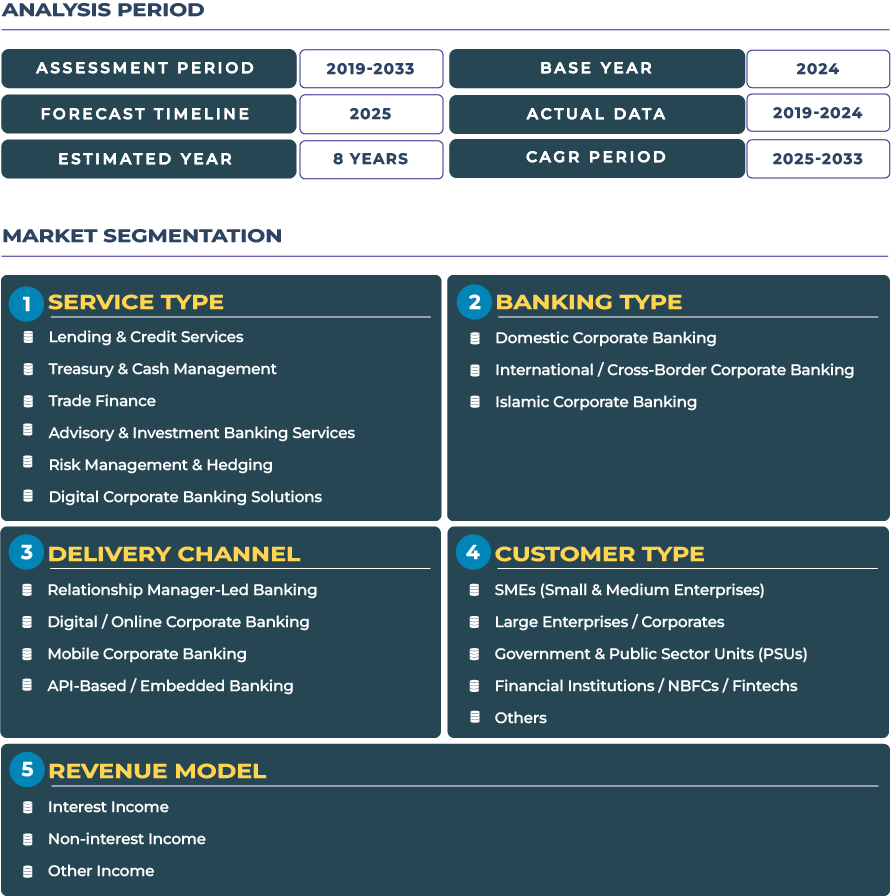Digital Trade Finance and Corporate Banking Transformation in Kenya
Kenya corporate banking landscape is undergoing a structural shift as lenders roll out digital platforms tailored to enterprises and high-growth SMEs. Banks are integrating trade finance tools, online treasury portals, and mobile-enabled cash management systems to enhance liquidity and streamline transactions. Institutions such as Central Bank of Kenya are reinforcing regulatory clarity around digital banking, while firms like KCB Group are scaling corporate payment platforms across East Africa. The momentum is driven by regional trade flows, logistics hubs in Nairobi and Mombasa, and integration into continental markets through the African Continental Free Trade Area (AfCFTA). The Kenya Corporate Banking Market is projected to reach USD 2.3 Billion in 2025 and grow to USD 2.9 Billion by 2033, reflecting a CAGR of 2.9% as per DataCube Research. Demand for trade digitization, cross-border receivables, and scalable SME lending platforms is fueling this trajectory despite macroeconomic and regulatory complexities.
Note:* The market size refers to the total revenue generated by banks through interest income, non-interest income, and other ancillary sources.
Market Outlook: Digital Platforms Powering Trade Finance and SME Growth
The corporate banking market in Kenya is transitioning from branch-led transaction services to platform-based financial ecosystems designed for enterprises. Corporate clients increasingly seek integrated liquidity dashboards, trade documentation automation, and cross-currency settlement capabilities. The emphasis on corporate digital banking has become central for logistics firms, agribusiness exporters, telecom operators, and professional services companies looking to optimize working capital. The expected Kenya corporate banking market size growth from hinges on rising adoption of mobile-backed receivables systems, increased participation in syndicated trade facilities, and collaboration between local commercial banks and global development finance bodies. Political reforms, digital public infrastructure, and East African trade corridors are accelerating credit access and supply-chain financing solutions. However, inflation volatility, currency depreciation pressures, and post-pandemic liquidity constraints continue to test balance sheet resilience. The market’s gradual expansion remains anchored in strengthened fintech integration, localized treasury products, and trade corridor financing mechanisms.
Drivers & Restraints Shaping Corporate Banking Performance
Drivers: Expanding Trade, Enterprise Digitization, and Mobile Integration
Kenya’s position as a regional logistics and trade hub has intensified demand for corporate financial services. Exporters in tea, flowers, and horticulture require trade finance, receivables insurance, and FX hedging to manage seasonal capital needs. The rapid adoption of mobile money in B2B settlements is reshaping receivables management for mid-sized enterprises. Partnerships between banks and fintechs are enabling mobile-integrated payroll, cash flow dashboards, and real-time payables. These developments drive transaction volumes, cross-border financing activity, and liquidity optimization services.
Restraints: Informal Business Structures and Cross-Border Challenges
Informal sector dominance makes it difficult to assess creditworthiness, especially for SMEs lacking documented cash flows. Many local banks face constraints in underwriting large-scale infrastructure or syndicated project loans due to capital adequacy and risk exposure considerations. Cross-border trade settlement across East Africa remains slowed by divergent regulations, currency mismatches, and compliance overheads. Persistent security risks in parts of the region add complexity to asset protection, FX flows, and correspondent banking arrangements. The combined effect moderates overall corporate banking expansion despite rising demand.
Trends & Opportunities in Kenya Corporate Banking Ecosystem
Trends: Digital Treasury, Supplier Finance, and Cross-Border Integration
Corporate integrations with mobile platforms such as M-Pesa and bank APIs are transforming payment cycles. Institutions are building supplier finance systems that facilitate early invoice settlement for agricultural and manufacturing exporters. Increasing focus on financing trade corridors linking Kenya to Tanzania, Uganda, Rwanda, and beyond is boosting currency settlement services. The expanding corporate digital banking ecosystem is also accommodating ESG-driven working capital for agribusiness, logistics operators, and energy firms.
Opportunities: Mobile Corporate Payments and Regional Trade Finance Growth
There is rising potential in mobile-based corporate payment volumes, especially among mid-sized enterprises. Supplier finance uptake in agriculture is unlocking liquidity across export clusters. Regional trade finance volumes tied to AfCFTA and EAC agreements are providing banks with new avenues for transactional growth. These opportunities support broader market diversification, particularly in receivables discounting, supply-chain credit lines, and multi-currency cash management products adapted to cross-border operations.
Competitive Landscape: Digital Integration and Regional Finance Strategies
Kenya corporate banking environment includes local leaders such as Co-operative Bank of Kenya and international players with cross-border reach. Banks are developing integrated receivable platforms, mobile treasury systems, and trade finance desks dedicated to East African trade flows. Strategic positioning includes mobile-linked payable solutions for enterprises, structured finance products for exporters, and corridor financing linked to regional logistics hubs. These market participants are also exploring ESG-focused funding models, invoice discounting for export segments, and partnerships with payment technology providers to address working capital cycles and risk mitigation.







